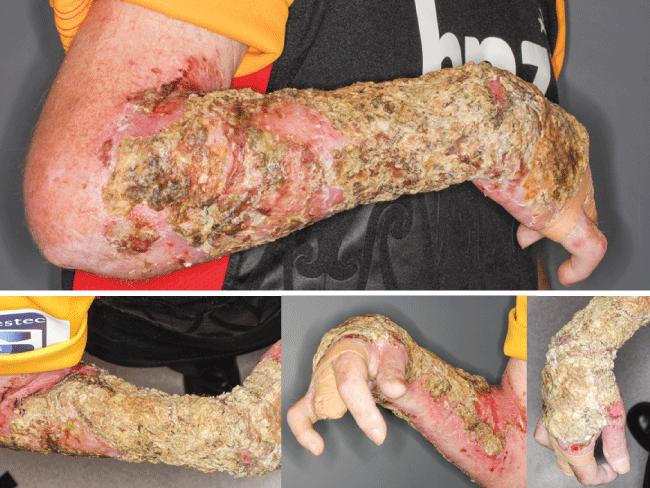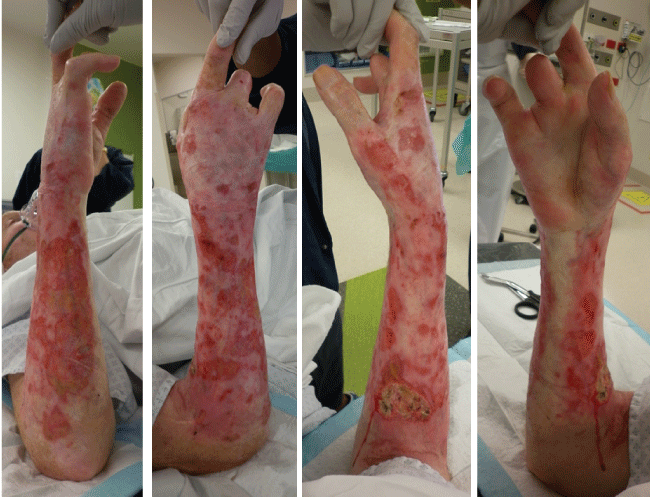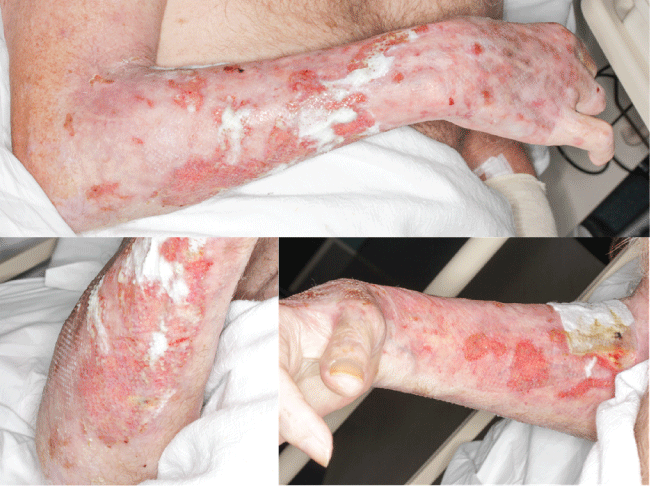Journal of Dermatology Research and Therapy
A Rare Case of Erosive Pustular Dermatosis Involving the Upper Limb
Paul Ting-Yuan Cheng1,2*, Lissa Elaine Judd3 and Agneta Carol Fullarton2
1Department of Plastic & Reconstructive Surgery, Middlemore Hospital, New Zealand
2Department of Plastic & Reconstructive Surgery, Hutt Hospital, New Zealand
3Dermatologist, Anwyl Specialist Medical Centre, Paremata, Porirua, New Zealand
*Corresponding author:
Dr. Paul T. Cheng, Department of Plastic & Reconstructive Surgery, Middlemore Hospital, Counties Manukau District Health Board, Hospital Road, Otahuhu, Auckland, New Zealand, Tel: +64-21-2581-777, E-mail: paul.cheng@middlemore.co.nz
J Dermatol Res Ther, JDRT-2-015, (Volume 2, Issue 1), Review Article; ISSN: 2469-5750
Received: January 29, 2015 | Accepted: February 26, 2016 | Published: February 29, 2016
Citation: Cheng PTY, Judd LE, Fullarton AC (2016) A Rare Case of Erosive Pustular Dermatosis Involving the Upper Limb. J Dermatol Res Ther 2:015. 10.23937/2469-5750/1510015
Copyright: © 2016 Cheng PTY, et al. This is an open-access article distributed under the terms of the Creative Commons Attribution License, which permits unrestricted use, distribution, and reproduction in any medium, provided the original author and source are credited.
Abstract
Erosive pustular dermatosis (EPD) is a cutaneous inflammatory condition, characterized by chronically non-healing lesions with sterile pustules and hyperkeratotic crusted erosions. Although rare, severe cases have been referred by dermatologists to plastic surgeons for management. The aim of this paper was to describe the presentation and management of extensive EPD as well as a review of current literature on this rare condition.
A case of presumed EPD of twelve years duration was presented. Extensive nature of the disease in a man with background history of chronic regional pain syndrome necessitated referral to plastic surgery service from dermatology. This challenging case involved a malnourished patient with extensive area of his upper limb skin affected by hyperkeratotic crusting erosions with surrounding atrophic changes and joint contractures. After initial debridement and tissue biopsy to exclude malignancy, patient was kept inpatient for daily dressing changes and topical potent corticosteroid application with support of anaesthetic service. Significant improvement of the condition was evident with serial photographic documentation records.
Erosive pustular dermatosis, although rarely referred to plastic surgery, should be considered in the differential diagnosis of a non-healing wound. It should resolve readily with extended course of topical potent corticosteroid therapy.
Keywords
Erosive pustular dermatosis, Skin atrophy, Complex regional pain syndrome, Non-healing wound
Introduction
Erosive pustular dermatosis (EPD) is a cutaneous inflammatory condition, characterized by chronically non-healing lesions with sterile pustules and hyperkeratotic crusted erosions. Extensive or infected disease may result in significant scarring and contracture. Although relatively rare, severe cases have been referred by dermatologists to plastic surgeons for management.
Less than 200 cases have been reported in literature since late 1970s, when it was first described, with most cases involving the scalp with actinic changes or the legs with venous insufficiency [1-3]. We describe here a case of presumed EPD involving the majority of an upper limb of twelve years duration, associated with upper limb complex regional pain syndrome (CRPS).
Patient and Methods
A 61-year-old, right-hand-dominant ex-salesman had a history of previous trauma to right hand approximately 20 years ago, resulting in ray amputation of his right ring finger and subsequent proximal inter-phalangeal joint of his right middle finger in 2002. This was complicated by development of chronic CRPS affecting the majority of the right hand and forearm. These areas had subsequently developed extensive hyperkeratotic crusting erosions involving almost entire right dorsal hand, forearm extending to elbow joint and distal arm, with surrounding atrophic skin changes and fixed joint contractures (Figure 1). There was a possible history of self-rubbing/irritating the skin (which the patient himself vehemently denied).

.
Figure 1: Photographs showing extensive hyperkeratotic crusting erosions with surrounding atrophic changes and joint contractures of the right upper limb.
View Figure 1
His general practitioner had managed this man in the community with antibiotics for extended period with minimal improvement, until recent referral in 2013 to dermatologist who considered this to be a form of EPD. He had since been referred to the regional Plastic Surgery service for debridement and tissue biopsy as well as subsequent daily dressing and topical corticosteroid application (Dermol™, Clobetasol propionate 0.05% cream, Mylan New Zealand Ltd), due to his background of CRPS precluding this being done as an office procedure.
Multi-disciplinary inputs (e.g. the anaesthetists and pain service, psychologist, physiotherapists, dietitian, plastic surgeons and nurses) received during inpatient stay (Hutt Hospital, Wellington, New Zealand) for 20 days before discharging to regional centre where topical treatment continued and followed up by dermatology. Histology excluded invasive malignancy and was consistent with clinical diagnosis of EPD.
Informed consent was obtained from this patient for publication of the case and the use of clinical photographs taken intra-operatively.
Results
Significant improvement of the condition was evident with serial photographic documentation records (Figure 2 and Figure 3) whilst the patient was inpatient. After discharge from hospital, however, the patient was found to be non-compliant with the daily topical steroid treatment prescribed and subsequently had developed relapse.

.
Figure 2: Intra-operative photographs 4 days after initial debridement and daily topical Dermol™ application with change of dressings.
View Figure 2

.
Figure 3: Photographs showing clinical improvement after 12 days of Dermol™ application, with re-epithelisation of approximately 70% of erosive lesions.
View Figure 3
Discussion
EPD is a relatively under-diagnosed cutaneous inflammatory disease of unknown aetiology. Since its first description in the late 1970s [1,2], there are only approximately 160 cases reported in the literature. It has been described to mostly affect either the scalp or the leg.
• EPD of the scalp is a condition reported mostly in elderly patients who have had prolonged sun exposure, triggered by a local trauma such as injury, skin cancer, surgery, etc [2,4,5].
• EPD of the leg has been described as a rare form in patients with longstanding venous insufficiency and stasis skin changes [6,7].
Clinical features of EPD are erythematous, pustular lesions with crusted erosions. Histology usually shows non-specific chronic inflammation with neutrophilic infiltration, as is shown in our case. The usual misdiagnoses are infection or malignancy. These EPD skin lesions are almost always resistant to local or systemic antibiotic treatment, but the condition usually responds to potent topical steroid agents (though relapse is possible) [2,5,8-10].
Recently EPD has been described in patients with non-healing burn wounds [8,10]. It, however, has never been reported in the setting of atrophic skin changes relating to CRPS which is not an uncommon entity amongst patients of the plastic/hand surgeons.
Our original case has demonstrated some characteristic clinical and histo-pathological features suggestive of EPD, and other dermatological diagnoses have been excluded by histo-clinical correlation. We speculate that the sensory and atrophic skin changes associated with CRPS may be prone to irritants and thus resulting in development of this chronic disabling condition. The history of possible self-rubbing/irritating the already sensitive skin may also be related.
Although a challenging case at time, our patient’s condition had responded well to an extended course of topical corticosteroid treatment whilst inpatient. It also had demonstrated the likelihood of disease relapse if non-compliant to prescribed treatment. Multi-disciplinary team inputs are the key in the management of these patients.
Conclusion
Erosive pustular dermatosis, although rarely referred to plastic surgery, should be considered in the differential diagnosis of a non-healing wound. It should resolve readily with extended course of topical potent corticosteroid therapy. Patients should be informed regarding the importance of treatment compliance and the potential for relapse.
Acknowledgements
The authors acknowledge the support of our multidisciplinary team in managing this challenging case. There was no conflict of interest in the preparation and submission of this manuscript.
Previous Presentation
Poster presentation during the New Zealand Association of Plastic Surgeons Annual Scientific Meeting (5-7 September 2014) in Queenstown, New Zealand.
References
-
Burton JL (1977) Case for diagnosis. Pustular dermatosis of scalp. Br J Dermatol 97 Suppl 15: 67-69.
-
Pye RJ, Peachey RD, Burton JL (1979) Erosive pustular dermatosis of the scalp. Br J Dermatol 100: 559-566.
-
Semkova K, Tchernev G, Wollina U (2013) Erosive pustular dermatosis (chronic atrophic dermatosis of the scalp and extremities). Clin Cosmet Investig Dermatol 6: 177-182
-
Grattan CE, Peachey RD, Boon A (1988) Evidence for a role of local trauma in the pathogenesis of erosive pustular dermatosis of the scalp. Clin Exp Dermatol 13: 7-10.
-
Levakov O, Gajić B (2014) Erosive pustular dermatosis of the scalp-is it really a rare condition? Vojnosanit Pregl 71: 307-310.
-
Brouard MC, Prins C, Chavaz P, Saurat JH, Borradori L (2002) Erosive pustular dermatosis of the leg: report of three cases. Br J Dermatol 147: 765-769.
-
Cotterill JA, Lanigan SW (1990) Erosive pustular dermatosis of the leg--a definition. Br J Dermatol 123: 548.
-
Al-Benna S, Johnson K, Perkins W, O'Boyle C (2014) Erosive pustular dermatosis: new description of a possible cause of the non-healing burn wound. Burns 40: 636-640.
-
Jourdan M, Chaby G, Meziane L, Arnault JP, Chatelain D, et al. (2012) A case associating an erosive pustular dermatosis of the legs and scalp. Case Rep Dermatol 4: 186-191.
-
Mizutani H, Suehiro M, Okuzawa Y, Masuda K, Katoh N (2013) Erosive pustular dermatosis of the arm following burn injury. Acta Derm Venereol 93: 757-758.





